Last Updated on June 21, 2024 by Kittredge Cherry
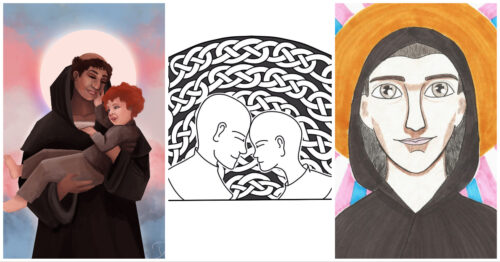
Marinos or Marina the Monk has been called a patron saint of transgender parenting or a cross-dressing saint. Assigned female at birth, Marina adopted the name Marinos and entered a monastery as a man in fifth-century Lebanon. Marinos embraced a male identity from that point onward, even after being falsely accused of fathering a child. He adopted the boy and raised him as his own son.
Marinos’ popularity is rising along with the visibility of transgender rights. This queer saint was added to the Episcopal calendar of saints in 2022 with a feast day on June 17. The saint is celebrated on June 18 in the Roman Catholic Church and on other dates in other traditions.
Marinos belongs to a group of transgender or cross-dressing saints with similar stories. All were raised as girls and then joined monasteries where they lived as male monks. Their female upbringing and anatomy were not discovered until they died. In 2024 Marinos became the most popular of these gender-expansive saints at Q Spirit, surpassing to Wilgefortis for the first time.
Artists create queer images of Marinos
Every year more artists are portraying Marinos as a queer saint in new artwork.
New in 2024: A new image of Marinos was created in 2024 for the forthcoming book “Legends from Lindisfarne: Diverse and Inclusive Saints” by Elizabeth Hopkinson (author) and Anna Hopkinson (illustrator). The black-and-white illustration has a Celtic vibe with decorative knotwork arching behind the saint like a rainbow or halo. A Kickstarter fundraiser to finance the illustrated book is underway with a deadline of June 22, 2024.
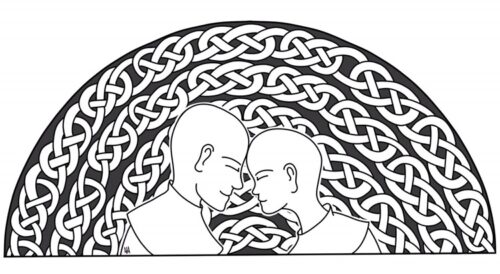
Illustration for “Marinos: The Trans Monk” by Anna Hopkinson from the book “Legends from Lindisfarne: Diverse and Inclusive Saints.” Prints of this and other images from the book are available at the illustrator’s Ko-Fi shop.
Two queer-affirming chapters — “Marinos: The Trans Monk” and “Our Lady of Montevergine: Affirmer of Same Sex Partners” — are included in a digital “Pride Sample” from the book. The Pride Sample is available at the author’s Ko-Fi shop. All proceeds will go toward crowd-funding the book. Based in the United Kingdom, Elizabeth and Anna Hopkinson are a mother-daughter team that also joined forces on the “Asexual Fairy Tales” series.
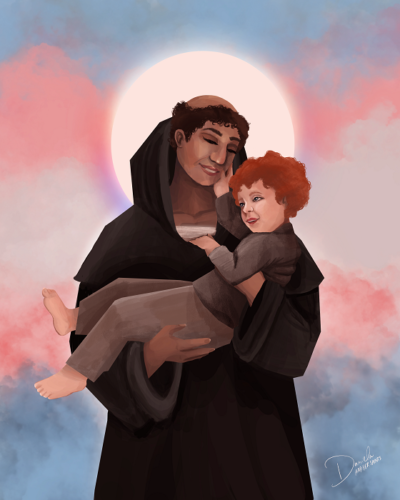
“Marinos the Monk” by Dani of And Her Saints on Etsy
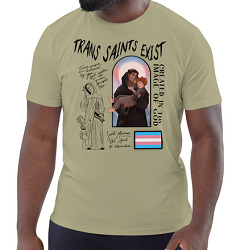 An icon of Marinos the Monk was created in 2022 by Dani, an LGBTQ-affirming Catholic artist based in California. Unlike traditional portraits of Marinos, the new icon shows him as joyful. The smiling monk happily holds his adopted son while the clouds behind them glow with the colors of the transgender flag. The icon appears on the “Trans Saints Exist” shirt at the And Her Saints Etsy shop. Her work is also featured on the And Her Saints Instagram account.
An icon of Marinos the Monk was created in 2022 by Dani, an LGBTQ-affirming Catholic artist based in California. Unlike traditional portraits of Marinos, the new icon shows him as joyful. The smiling monk happily holds his adopted son while the clouds behind them glow with the colors of the transgender flag. The icon appears on the “Trans Saints Exist” shirt at the And Her Saints Etsy shop. Her work is also featured on the And Her Saints Instagram account.
Rays of light shine with the pink, blue and white colors of the transgender flag in “Marina the Monk” by Matthew. He is a practicing Roman Catholic who shares his artwork at Queer Catholic Icons on Instagram as @queer.catholic.icons.
“Marina the Monk” by Matthew of Queer Catholic Icons.
When he posted the icon in 2023, Matthew wrote, “Whether or not he would be considered transgender in the most recent sense of the word, it is undeniable that his story speaks to the trans experience, and his sainthood shows that trans people are also integral parts of the Kingdom of God. Our lives can be as holy as anyone else’s, and Heaven has room for us, too. Saint Marina, pray for us!”
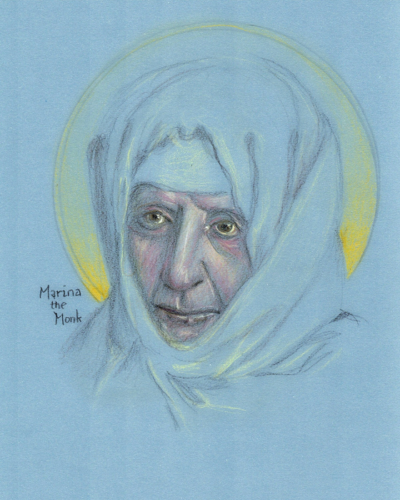
“Marina the Monk” by Tobias Haller
“Marina the Monk” appears older but still luminous in an icon sketched in 2023 by Tobias Haller an iconographer, author, composer, and retired vicar of Saint James Episcopal Church in the Bronx, still assisting at a parish in Baltimore, Maryland. Haller enjoys expanding the diversity of icons available by creating icons of LGBTQ people and other progressive holy figures as well as traditional saints.
Marinos in books and video
“Morine,” an award-winning Lebanese movie based on the life of this saint was released in 2018 by writer/director Tony Farjallah. The video trailer gives a vivid impression of the saint’s life and times, even for those who don’t speak Arabic.
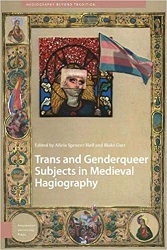 A chapter titled “The Authentic Lives of Transgender Saints: Imago Dei and Imitatio Christi in the Life of St Marinos the Monk” is included in the 2021 scholarly book “Trans and Genderqueer Subjects in Medieval Hagiography.” In this chapter, M.W. Bychowski unpacks the discussion of Marinos in Magnus Hirschfeld’s 1910 book “Transvestites,” critiquing the tradition of using the term “transvestite” saints and proposing new alternatives to improve understanding of medieval transgender saints. Bychowski’s writings on the saint also appear on the Transliterature website, which has pages on the imago dei and queer Christian images of Marinos the Monk. Earlier versions of The book also has a chapter on Madre Juana de la Cruz as a “gender-transcendent prophetess” by Franciscan scholar Kevin Elphick, who wrote the following article. He recommends Marinos as a role model for transgender parenting and patron saint for the trans community.
A chapter titled “The Authentic Lives of Transgender Saints: Imago Dei and Imitatio Christi in the Life of St Marinos the Monk” is included in the 2021 scholarly book “Trans and Genderqueer Subjects in Medieval Hagiography.” In this chapter, M.W. Bychowski unpacks the discussion of Marinos in Magnus Hirschfeld’s 1910 book “Transvestites,” critiquing the tradition of using the term “transvestite” saints and proposing new alternatives to improve understanding of medieval transgender saints. Bychowski’s writings on the saint also appear on the Transliterature website, which has pages on the imago dei and queer Christian images of Marinos the Monk. Earlier versions of The book also has a chapter on Madre Juana de la Cruz as a “gender-transcendent prophetess” by Franciscan scholar Kevin Elphick, who wrote the following article. He recommends Marinos as a role model for transgender parenting and patron saint for the trans community.
Marina the Monk: Saint for Our Day
In the 5th century, a child was born in Lebanon to her mother, Baddoura and her father, Eugenius. They named their daughter ‘Marina.’ Little could they have imagined that she would grow up to be both a monk and a saint. Her story is especially relevant today, touching upon themes of transgender rights, authenticity, and vocation. Her model of sanctity and integrity speaks to the crises of our times.
While Marina was still young, her mother died. Her father valiantly carried on, raising her as a single parent. When she was full-grown, Eugenius announced his intention to leave her an inheritance and enter the monastery of Qannoubine, Lebanon. At this news Marina shared with her father that she too believed herself to have the same vocation, and she asked to join him in entering the monastery. Fearing that her father might not let her accompany him, Marina asked: “Do you wish to save your own soul and leave mine to be lost? Do you not know that the Lord says: …’He who saves a soul shall be as the one who created it’?”
When her father expressed incredulity at her aspiration to join a men’s monastery, Marina explained her full intention: “Father, I will not enter the monastery in the way that you imagine, but will cut my hair and dress myself in men’s clothing; this is how I will come with you.” Her father then agreed to her plan, and she was subsequently renamed ‘Marinos.’ Both Eugenius and Marinos joined the monastic community together, beginning their new life there as male monastics.

Marinos (in red) arrives at the monastery with his father in a 14th-century French manuscript. (Wikipedia)
Marinos excelled in spiritual practice and virtue. He fasted regularly and had the gift of healing the infirm through the laying on of hands. He was addressed by his fellow monastics as “Abba Marinos” (Father Marinos). On one occasion the Abbot came to him and asked him to travel with three other brothers to attend to the business affairs of the community. This took them some distance, and an overnight stay at an inn was necessitated. The innkeeper had an unmarried daughter, who after their stay, began to evidence an unplanned pregnancy. When asked who fathered the unborn child, she blamed Marinos. The innkeeper traveled to the monastery and reported the accusation to the Abbot. When confronted, Marinos offered no defense, only acknowledging himself to be a sinful man before the Lord.
Seeing no other recourse, the Abbot expelled Marinos from the monastery. There Marinos remained, outside the gate, living in abject penitence for several years. When the innkeeper later brought his daughter’s newborn son to Marinos, the infant was adopted and raised by Marinos, fed by milk donated from nearby shepherds. Eventually the monks convinced the abbot to let Marinos rejoin them, as long as he did “hard labor” such as cooking, cleaning, and childcare in addition to his duties as a monk. Marinos raised the boy to adulthood, with him believing all the while that Marinos was his father. Following in his ‘father’s’ footsteps, he himself went on to join the same monastery.
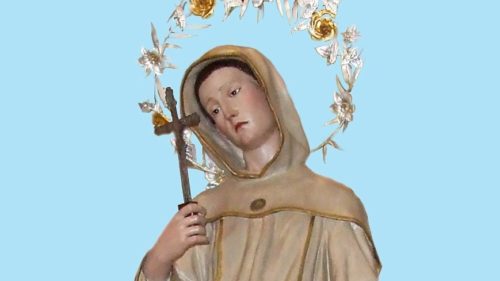
Statue of Saint Marinos / Marina the Monk by Vincenzo Zaffiro, 1800 (Wikipedia)
It was only upon Marinos’ death that his innocence became known. When Marinos did not arrive for community services, the brothers discovered his dead body his monastic cell. Upon cleaning and preparing Marinos’ body for burial, the brothers discovered that Marinos had been born female. Upon this revelation, the Abbot fell down beside Marinos’ body, weeping and saying: “I will remain here at his holy feet until I die, if I do not receive forgiveness.” In response, the voice of Marinos was then heard forgiving him. Upon her learning of Marinos’ birth gender, the innkeeper’s daughter immediately confessed to her false accusation, thereafter spending the remainder of her life in penitence at the tomb of Marinos. All the surrounding populace then came to know that Marinos was a saint.
How then can the story of St. Marinos the Monk speak to us today? Marinos responds with all the collective, sacred silence of the Fathers and Mothers of the Desert. When falsely accused, the answer from Marinos is to solely name our human condition before God: “Forgive me … for the Lord’s sake; for I have erred, being human.” There is no protestation of innocence. Marinos is confident in the innocence gained in Christ by living out his vocation and calling. A deeper truth wins out. Marinos is grounded in a mature and established identity that requires no defense. Marinos has confidence that the silent truth of his firm identity is louder than any false accusation.
Marinos can be a model and patron saint for the transgender community. Recent statements from the Vatican proclaim a willingness to engage in dialogue regarding our transgender siblings. Reclaiming and celebrating a litany of holy individuals who left behind their birth gender and who lived as religious men would be a good place to spark internal dialogue within the Church. These recognized saints are already-existing models of transgender holiness in the Christian family.
St. Marinos the Monk is paradigmatic in this regard. He knew his gender identity and spoke it to his father, telling him his very soul was at risk if he did not assume it. Marinos recognizes that he is a co-creator with God of his own gender identity: “The one who saves a soul shall be as the one who created it.” Marinos faults his father’s limited imagination, instead embracing his own autonomy to cut his own hair as he chooses and wear clothes traditional for men — “This is how I will come with you.” Marinos exercised his own agency and forged a personal path forward.
The transgender community will also recognize Marina’s appropriation of a new name, Marinos, conforming with his authentic identity. It is an ancient monastic tradition to assume a new name upon joining a monastic community. These rituals and precedent may help us to develop corresponding liturgy and ritual to demarcate gender transition. Invocation of a litany of saints like Marinos would help to both broaden and ground such ritual in a continuous, living tradition.
Marinos is also a model for transgender parenting. The son raised by Marinos knew only a father. So effective was Marinos’ modeling of gender, that the son embraced the same gender identity and profession. We read nothing in the hagiography recording the son’s reaction to the gender revelation at the death of Marinos. One might extrapolate from this that he had been parented so soundly in a grounded self-identity, that like Marinos, nothing troubled his profound desert calm. He was nurtured and loved by his father Marinos; nothing could dissuade him of this truth.
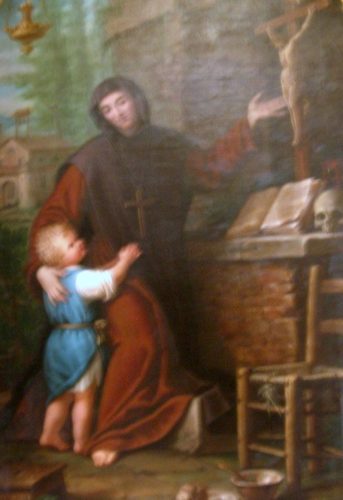
Saint Marinos teaches his adopted son in a painting at the Church of Santa Maria Formosa, Venice, Italy. The saint’s remains lay in a glass coffin below this painting for many years. (Wikipedia)
St. Marinos too is a model for the LGBT community. Presumptions about Marinos’ sexual behavior prompted the Abbot to cast Marinos outside the gate of the community. Yet Marinos stayed and remained faithfully connected to his brothers, even when forced outside their threshold. Herein is an apt metaphor for the Hierarchy’s treatment of the LGBT community and those of us who insist on faithfully remaining connected. Tellingly, by Marinos’ faithful witness and holy life, the Abbot eventually comes to the realization that Marinos’ body and genderedness are holy. Venerating the body, he acknowledges “his holy feet,” in this one phrase affirming both Marinos’ gender and the sanctity of that embodiedness. As the Abbot prostates himself before the incarnational mystery of Marinos, he finally hears Marinos’ authentic voice, a voice filled with understanding and forgiveness toward the Abbot. The dynamic between the Abbot and Abba Marinos is a powerful parable for the Church in our day. Marinos’ steadfast fidelity and the witness of a fully lived Christian life in the end win out.
Here in the 21st century, we can still hear the lingering voice of Marinos. St. Marinos calmly sits outside the gate of his monastery, holding his infant son in his embrace, feeding him goat’s milk, and softly telling him: “The one who saves a soul, shall be as the One who created it.” Nurtured and held in the same way, Marinos imagines himself similarly affirmed and embraced by the Christ. Clearly Marinos is a necessary and paradigmatic saint for our day.
The Coptic Church celebrates the Departure of St. Marina on August 21st. The Feast of St. Marina the Monk is celebrated on July 17th by the Maronite Church, and also by the City of Venice where the body had remained until last year when the remains were returned to Lebanon. The Roman Church celebrates the feast on June 18.
___
Quotations are taken from The Life of St. Marina by St. Symeon the Metaphrast and translated by Demetrios G. Tsames.
Full Text available at:
https://www.johnsanidopoulos.com/2011/02/saint-mary-of-alexandria-also-known-as.html
Prayers
Q Spirit’s Litany of Queer Saints includes this line:
“Saint Marinos, who left life as a woman to become a male monk and raise the child you were falsely accused of fathering, pray for us and inspire positive parenting.”
___

Kevin Elphick
Kevin Elphick is both a Franciscan scholar and a supervisor on a suicide prevention hotline in New York. He wrote a thesis on “Gender Liminality in the Franciscan Sources” for a master’s degree in Franciscan studies from St. Bonaventure University in New York. Elphick also has a master’s degree in Religious Studies from Mundelein College in Chicago and a Doctorate in Ministry from Graduate Theological Foundation with a focus in ecumenism. He writes occasionally for the Q Spirit blog about queer Franciscan subjects, including Francis of Assisi and Madre Juana de la Cruz. Elphick joined the Sisters of St. Francis in New York as a lay associate in 2014.
Links related to Saint Marinos / Marina the Monk
“Transgender Saints: The Imitatio Christi of St. Marinos the Monk” by M.W. Bychowski (Transliterature) “Rooted in the origins of the early Church, Marinos becomes a narrative and material foundation for later trans saints to be built upon. On this rock, Christ builds his transgender church,” Bychowski wrote.
“Transgender Icons: Queer Christian Images of Marinos the Monk” by by M.W. Bychowski (Transliterature)
Saint Marinos– Trans Monk, Beggar, and Adoptive Father (Friendly Fire Collective)
Marina/Marinos of Alexandria (Queering the Church)
Video: The Commemoration of the Departure of St. Marina, the Ascetic
صلاة قوس قزح المسيح (Rainbow Christ Prayer in Arabic)
Books related to Saint Marinos / Marina the Monk
“Crossdressing in Context, vol. 4: Transgender & Religion” by G. G. Bolich, (2009, ISBN 0615253563, pp. 86-87
“Clothes Make the Man: Female Cross Dressing in Medieval Europe” by Valerie R. Hotchkiss
“Holy Women of Byzantium: Ten Saints’ Lives in English Translation” by by Alice-Mary Talbot
___
Top image credit:
Collage with queer images of Marinos by, from left, Dani of And Her Saints, Anna Hopkinson, and Matthew of Queer Catholic Icons.
___
This post is part of the LGBTQ Saints series by Kittredge Cherry. Traditional and alternative saints, people in the Bible, LGBTQ martyrs, authors, theologians, religious leaders, artists, deities and other figures of special interest to lesbian, gay, bisexual and transgender and queer (LGBTQ) people and our allies are covered.
This article was originally published in August 2019, was expanded with new material over time, and was most recently updated on June 21, 2024.





















Wearing a monk’s habit does not prove that Marina was “transgender” since the context is vastly different.
She wasn’t transgedner or would ever have supported LGBTQ*+’s ungodly ways. She pretended to be a man so she can be a monk and live a life of ascetic self denial, not because she had a mental disorder. I hope you take this down and refrain from mentioning her name ever again.
She could have easily led a life of ascetic self denial as a nun. She may not have been transgender, but you don’t have the right to say what she would or would not support. Being LGBTQ+ is not a mental disorder. Do research and move on. God bless!
Dear Andy – as a Lebanese, one of an Eastern culture and well versed in my history and Orthodox faith, I can tell you this answer you have provided is not right. There were no female monasteries until much later, please refrain from making uneducated comments, the girl entered the male monastery with her father in his emotional protection and familiarity as his son. I invite you to imagine what it would have been like in a remote village in Lebanon, but first you must acquire the phronema of my people, not a western one of the 21st century. She did this for the love of God not for her own sexuality and earthly needs.
Dear Josette, St. Melania the Elder had established a female monastery around the time of St. Marina’s life (albeit in Jerusalem rather than in Lebanon).
St. Marina refused marriage to any man and continued to present as male even when accused of fathering an illegitimate child and after being cast out of the male monastery. She could have told people she was female at these trying times.
Even if she did not reveal herself to be female when accused of fathering a child, she could have lived as a female beggar instead of living as a male beggar while caring for the child after being cast out of the male monastery. Yet she continued to present as male.
I hope you can see how her strong refusal of marriage to any man and insistence on presenting as male even when it caused her hardship, coupled with her refusal to present as female even when she was not part of the male monastery anymore, makes LGBT people relate to her and think of her as one of their own: as a trans man who loved God and wanted to take good care of a child.
This is an amazing and enlightening story.
Thanks. I was looking for information about saint Marina and I found here.
Great work.
😉